If you ever enjoyed a salt beef bagel from an old-school Jewish deli, then you’re no stranger to traditional kosher dill pickles.
You can easily create your own traditional homemade fermented cucumber pickles that are just as crunchy, tangy, and delicious.
We will use the original lacto-fermentation method to make these classic lacto-fermented cucumber pickles, which are far tastier and healthier than store-bought dill pickles.
These deli-style cucumber pickles are full of gut-healthy probiotics, and you can control how tangy or mild you want it.
This recipe can be used to make half-sour pickles or full-sour pickles.
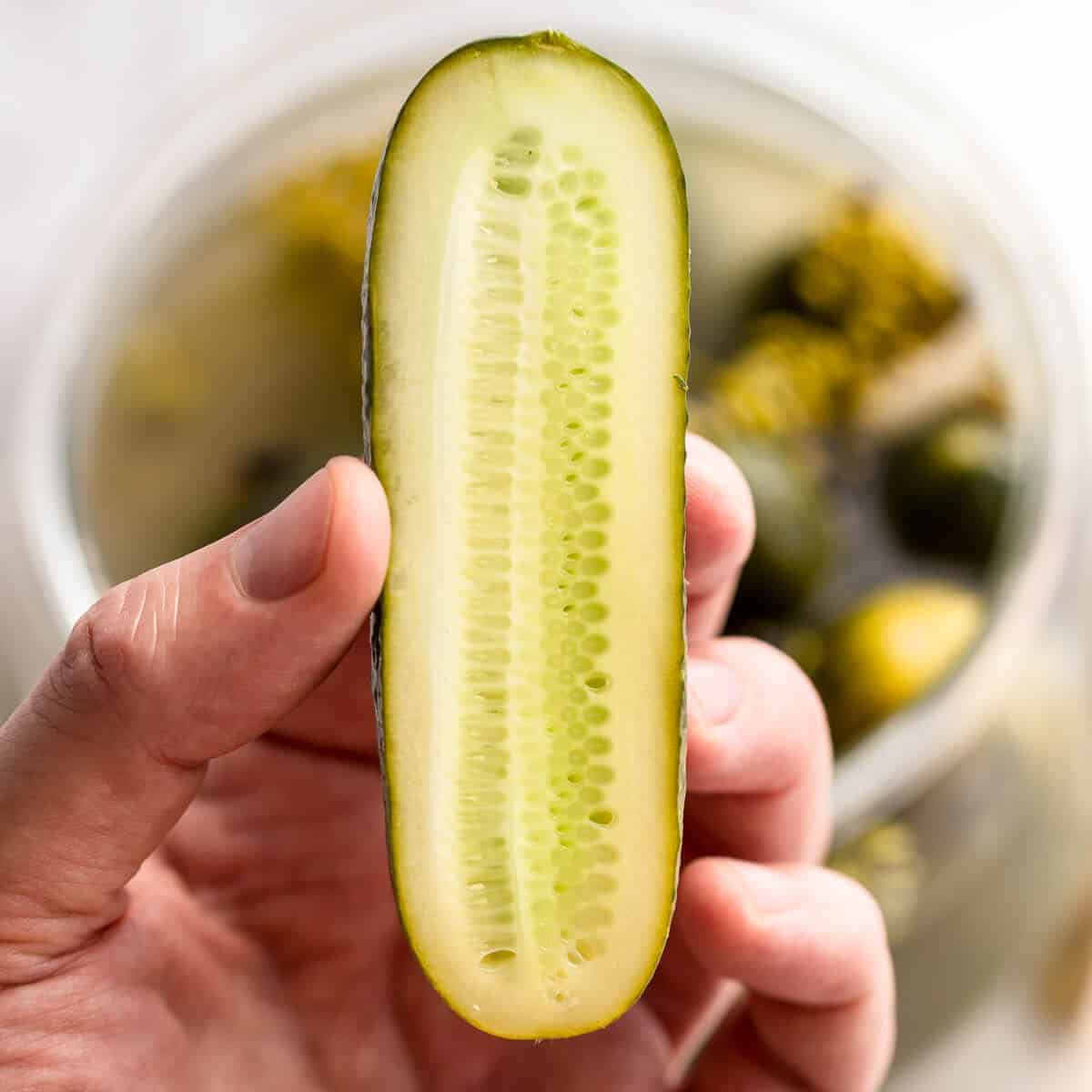
Jump to:
- What's the difference between fermented cucumbers and pickled cucumbers
- Lacto fermentation brine formula
- Which type of cucumber is the best to use?
- Ingredients
- Instructions
- Video instructions
- Storage instructions
- Food safety and tips when Fermenting
- Frequently asked questions
- Serving suggestions
- Useful equipment
- Related recipes
- Recipe
- Comments
What's the difference between fermented cucumbers and pickled cucumbers
Sometimes they're called pickles, even when Lacto-fermented like the old-school deli pickles. It’s not technically correct because pickles are not fermented cucumbers. Here's why.
- Pickled cucumbers - The sourness and sweetness are added in the form of vinegar and sugar. The acid in vinegar comes from acetobacter. Acetic acid-producing bacteria that need oxygen. These varieties are mainly sitting on the store shelf in jars and tins. The added vinegar prevents good or bad bacteria from growing, which makes it shelf stable but not very healthy. Although, still tasty.
- Fermented cucumbers - The sourness or tanginess are produced by lactic acid-producing bacteria. Called Lactobacillus. It naturally occurs on the skin of cucumbers and prefers an anaerobic or oxygen-free environment to thrive and produce fermented cucumbers. Traditional fermented cucumber pickles are not sweetened. Lacto-fermented foods are alive with good, healthy bacteria and need to be refrigerated as soon as the desired sourness is reached. Otherwise, it can over-ferment and taste bad.
So, the classic old-school cucumber dill pickles you've had in a deli are in fact fermented cucumbers and not pickled cucumbers found in tins or jars.
Much healthier, tastier and actually good for you.
Lacto fermentation brine formula
Weight of salt needed = (Weight of water needed to completely cover ingredients + weight of ingredients) X 0.02
This ratio will ensure the best environment for the lactobacillus to grow, while preventing unwanted bacteria from spoiling your ferment.
Which type of cucumber is the best to use?
If you are buying from a farmer’s market, then ask the vendor for pickling cucumbers or look for the Kirby cucumbers.
You want to avoid English cucumbers or anything with large seeds inside.
Make sure whichever cucumber you get is firm, unblemished and super fresh. Substandard cucumbers will only deliver a bad result.
Ingredients
Make sure you have a nice big fermentation vessel or container before you start. Use kitchen weighing scales if you can. It’s more accurate than spoons and cups, and you need to be accurate when fermenting cucumbers or any other ferment.
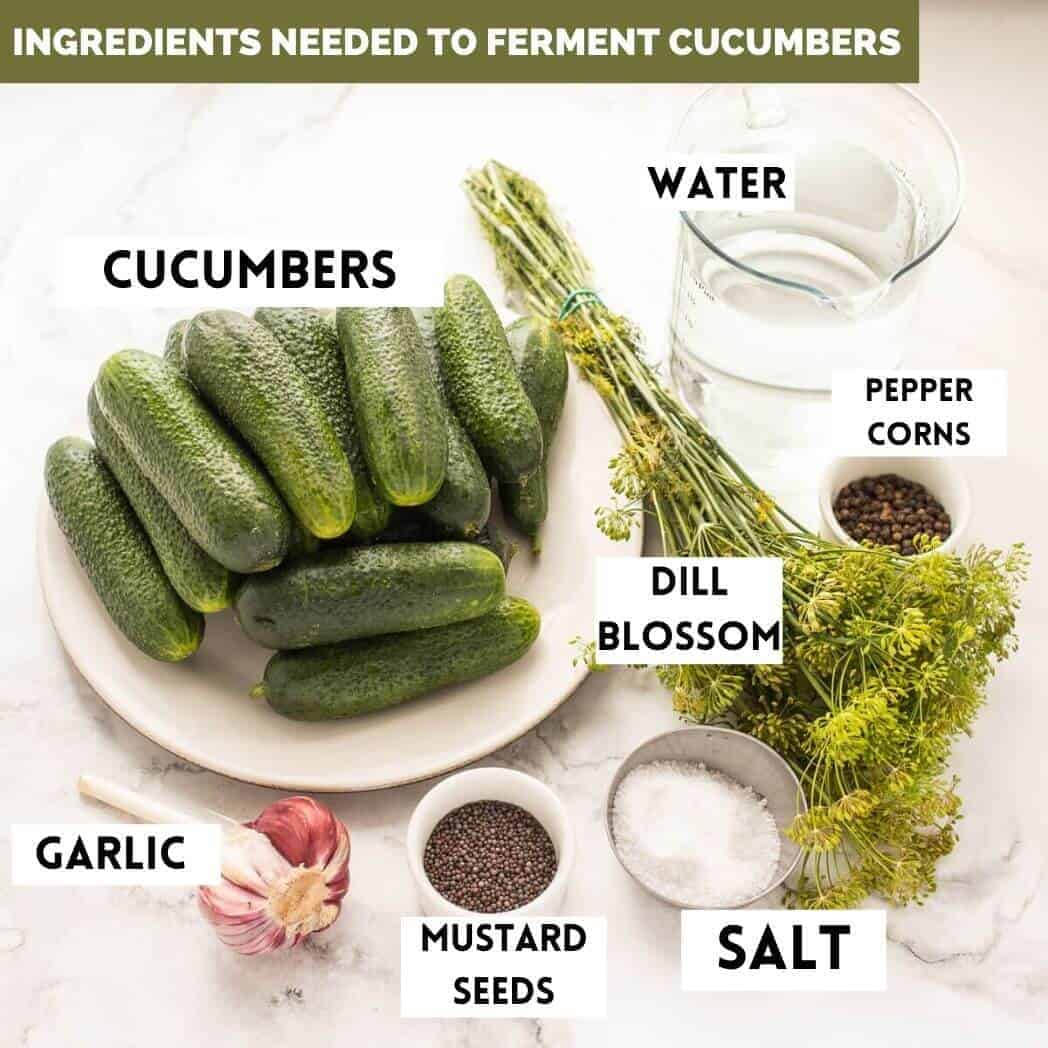
- Cucumbers – Use fresh, crisp, and preferably seasonal medium-sized pickling cucumbers about 10 cm or 5 inches long and 3-4 cm or 1.5 inches in diameter.
- Water – Good quality clean drinkable water.
- Salt – Natural salt. Don’t use iodised, as it contains some mild antibacterial properties. We need bacteria for this to work.
- Dill – I used fresh dill blossom but you can easily replace it with fresh dill.
- Garlic – Use the freshest, nicest and juiciest garlic you can find.
- Pickling spices (optional) – I used whole black mustard seeds but, you can use regular or just leave it out. If you want you could also add things like bay leaf, all-spice, juniper, dill seeds, or chilli flakes. You could also add fresh chilli if you like.
Instructions
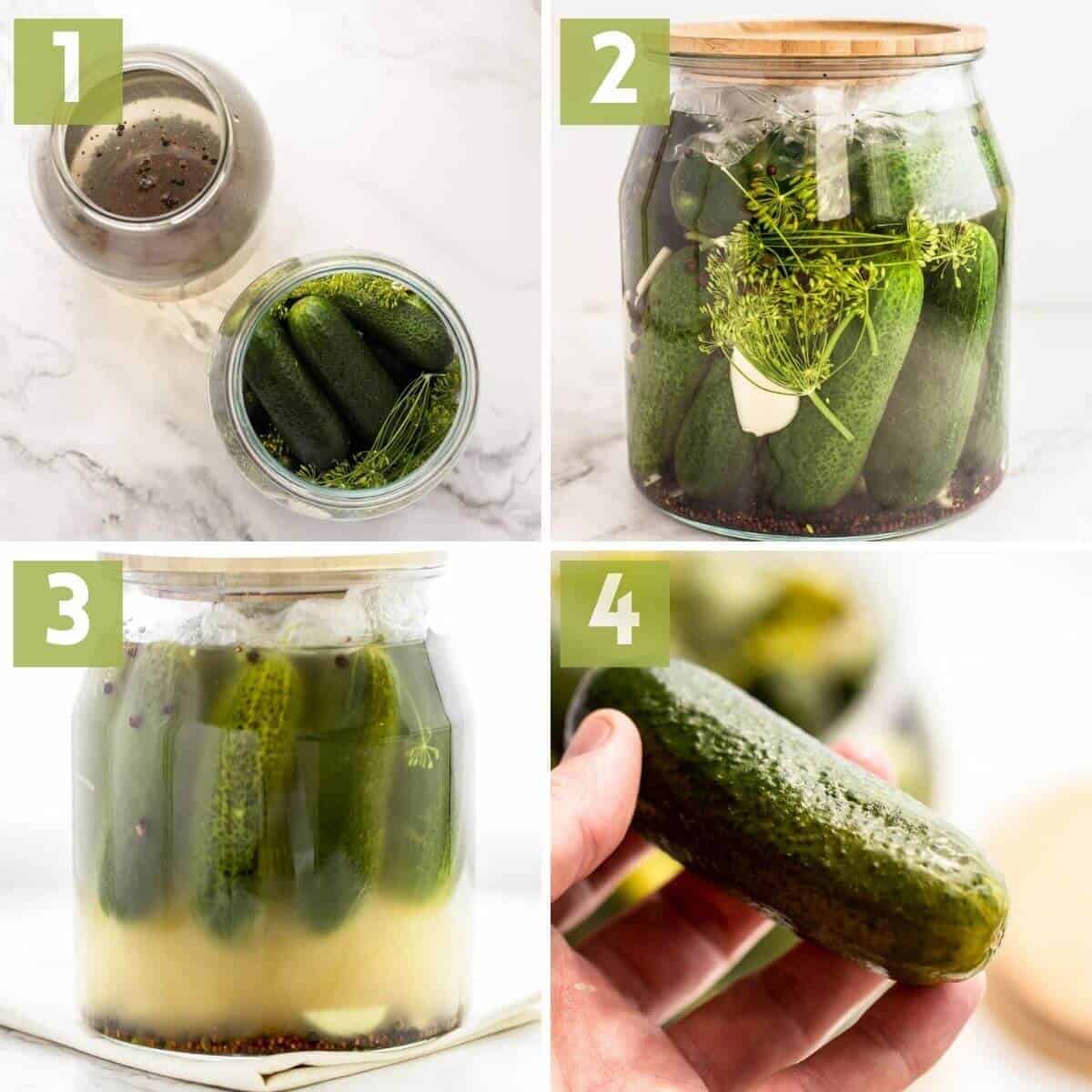
- Wash the cucumbers under cold running water. Place a large properly cleaned 3L Glass jar or plastic bucket onto the scales and zero the weight. If you do things in gallons then use a 1-gallon container. Make sure to wash the container, your hands, and utensils properly to avoid any unwanted bacteria.
- Add the cucumbers so that they fill the container, with some room at the top.
- Fill the container up with water taking note of the total weight of the ingredients and the water. Again, leaving some room at the top.
- Multiply that number by 0.02. That is the amount of salt needed in the recipe. Pour the water out into a jug or container and mix in the salt until fully dissolved along with the garlic, mustard seeds, and dill blossom. Now you have the fermentation or pickling brine.
- Pour this brine back into the vessel with cucumbers and place a small plate on top or a plastic bag filled with water. This is to make sure the cucumbers stay submerged in the brine.
- Close the container with a lid, leaving 4cm or 2 inches room at the top of the vessel, and let the cucumbers ferment at room temperature (21 degrees Celsius or 69 degrees Fahrenheit) for 5 to 12 days or until you are happy with their taste.
The fermentation time will depend on the average temperature. The general rule is. The warmer, the quicker it ferments. So, give it a taste after about 3 days, and then every few days after that until you are happy with the amount of sourness.
Never let your ferment go above 28 degrees Celsius or 82 degrees Fahrenheit. It will ferment too quickly and produce strange, off-flavours.
Wild fermentation, like this, is something you’ll learn over time and the more you practice and the more foods you ferment, the more you will get the hang of it.
Video instructions
Storage instructions
As soon as your cucumbers are ready, you should move them to the fridge. Brine-and-all.
Fermentation will slow down significantly in the fridge, but won’t completely stop. For this reason, they are best consumed within a few weeks to a month.
I usually finish mine way before that, though.
Food safety and tips when Fermenting
Whenever you ferment anything, there are a few simple safety steps to remember.
- Wash your hands, utensils, and work surfaces with soap and water. You need a clean but not sterile environment for wild fermentation to work.
- Rinse the produce you plan to ferment under cold running water to make sure it's clean and dirt free.
- Monitor your ferment daily by looking at it and smelling it. It should never look strange and have green or funky-coloured moulds growing on it. Neither should it smell revolting nor off. It should be lively and might slightly bubble with a pleasant healthy sour funky smell.
- If you suspect a ferment has gone, throw it out and start over to avoid risking possible negative outcomes.
- As a bonus or extra step, you can test the pH of your ferments with a cheap pH strip to make sure that they're slightly acidic.
Frequently asked questions
They should taste pleasantly sour, but not overly so. It will also have a slightly savoury, umami taste. Their texture should be crunchy when you bite into them and the inside, not mushy. Those are the qualities of the perfect fermented cucumber dill pickle.
Unwanted bacteria crept in. Make sure that you clean your equipment well before starting to make a ferment.
There is something called kahm yeast that might look like a thin white film of mould but, is actually harmless. Just carefully remove it from the top if it does appear, as it can affect the flavour of a ferment.
If you start with perfect cucumbers, they will probably not need any help keeping crispy. I never use any of these methods, but you can do the following to ensure crispiness.
Soak the cucumbers in ice water for 5 minutes and add a grape leaf or bay leaf to the brine. It contains tannin that helps keep the skin crispy.
I find that they are best consumed within a month. Although, you can keep them in the fridge for up to 6 months, correctly stored without introducing bad bacteria through contaminated utensils or dirty hands.
Botulism is rare but mostly occurs with completely sealed, canned, salted, and low-acid foods. More often than not, root vegetables or wild mushrooms because of the contact with soil (Botulism is found in soil).
With fermented cucumbers, you don't run that risk.
Serving suggestions
Apart from being a healthy snack, fermented cucumbers pickles can be used in various other dishes and preparations like the following:
- As a fresh tangy side with rich meat dishes like crispy pork belly, lamb chops, koftas or ribeye steak.
- Same goes for fish like grilled angelfish or pan-seared salmon. If you making a tartar sauce for these then use these instead of store-bought gherkins.
- I also like adding a spoon or two to stews or chilled/hot soups right before serving. Like this Ukrainian beetroot soup or this Viking stew. It gives a nice bit of balance and brings nuance to the dish.
- Serve alongside other snacks like Moroccan zaalouk or green pea and feta dip.
Useful equipment
Related recipes
This site contains affiliate links. I may earn a tiny commission on qualifying purchases at no extra cost to you. By bookmarking these links you help support the upkeep of this site.
If you found this post helpful or have learned something, comment, subscribe, and follow me on social platforms for more tasty recipes.
Recipe
Easy Homemade Fermented Cucumber Dill Pickles (Video)
Ingredients
- 1300 g (2.87 lb) cucumbers - pickling or Kirby
- 1400 g (3.09 lb) water - clean drinkable
- 54 g (3 tablespoon) salt - pure non-iodized
- 8 each garlic cloves - optional
- 4 g (1 teaspoon) mustard seeds - optional
- 4 g (1 teaspoon) black peppercorns - optional
- ½ bunch (1 cup) dill blossom or fresh dill - optional
Instructions
- Wash the cucumbers under cold running water. Place a large properly cleaned 3L Glass jar or plastic bucket onto the scales and zero the weight. If you do things in gallons then use a 1-gallon container. Make sure to wash the container, your hands and utensils properly to avoid any unwanted bacteria from joining the party.
- Add the cucumbers so that they neatly fill the container.
- Fill the container up with water taking note of the total weight of the ingredients and the water.
- Multiply that number by 0.02. That is the amount of salt needed in the recipe. Pour the water out into a jug or container and mix in the salt until fully dissolved along with the garlic, mustard seeds and dill blossom. Now you have the brine.
- Pour this brine back into the vessel with cucumbers and place a small plate on top or a plastic bag filled with water. This is to make sure the cucumbers stay submerged in the brine.
- Close the container with a lid, leaving 4cm or 2 inches room at the top of the vessel, and let the cucumbers ferment at room temperature (21°C or 69°F°) for 5 to 12 days or until you are happy with their taste.
Video
Notes
- The time differs as temperature differs from place to place and time of day. The general rule is. The hotter, the quicker it ferments. So, give it a taste after about 3 days and then every few days after that until you are happy with the amount of sourness.
- I give you this extra in-depth knowledge because your vessel might be different and you might use differently sized cucumbers as well as ferment at different temperatures. Never let your ferment go above 28C or 82F. It will ferment too quickly and produce strange flavours.
- Wild fermentation, like this, is something you’ll learn over time and the more you ferment the more you will get the hang of it. It’s that simple.
- See post for more information on storage and troubleshooting

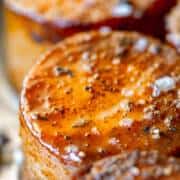
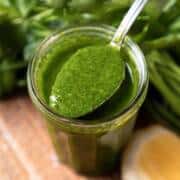

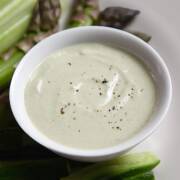
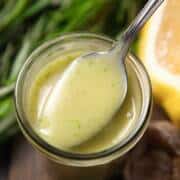
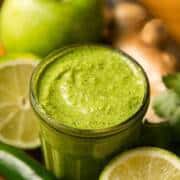


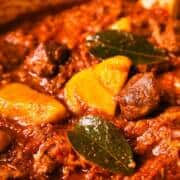
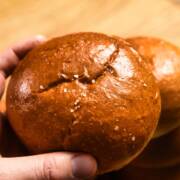
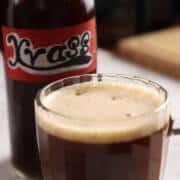

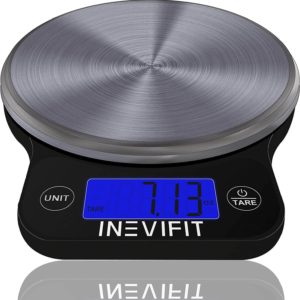
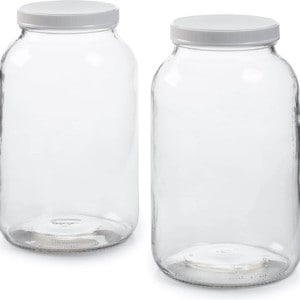

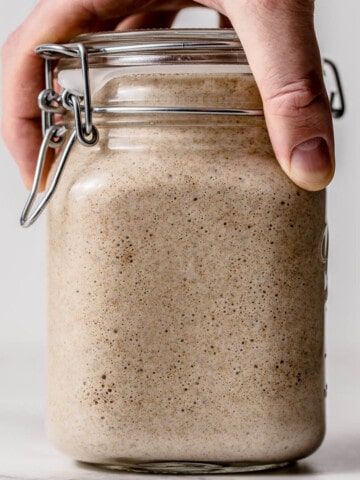
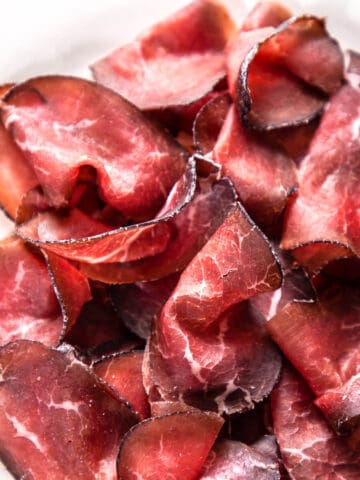
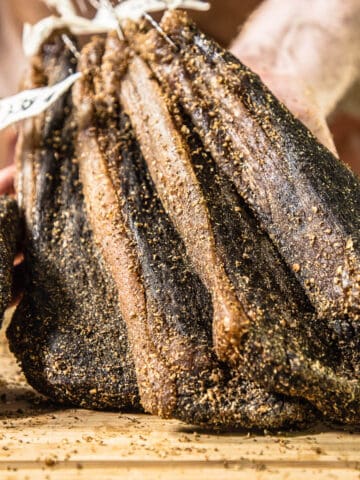
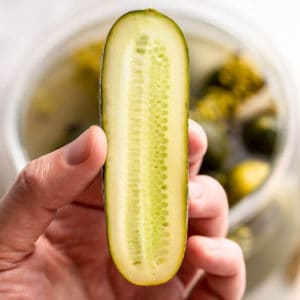
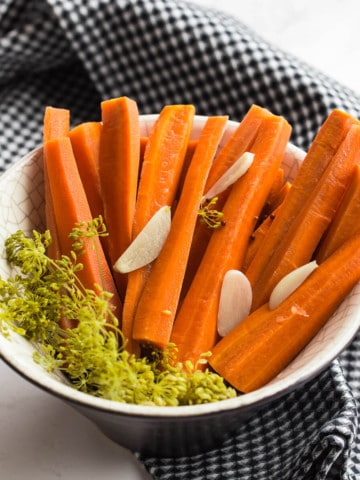



Kiril
Came out perfect. Great fermented cucumber recipe! Thanks
Charlé
Nice one Kiril! Happy you call them fermented cucumbers instead of pickles)) If you like fermentation then check out my sriracha recipe. It's the bomb! Or, if you want to take your fermentation game to the next level read my post on koji. You can ferment your own soy sauce, miso and many other popular and even undiscovered ferments along the way. Happy fermenting!
Lynda Magirl
I made these fermented cucumbers with my homegrown pickling cucumbers and after three days of fermenting, I just tried them and really like them. They have a nice mild flavor. Definitely will make more. Thanks for the awesome healthy recipe!
Bodil
Great explanation and recipe.. can I cut the cucumbers into slices? I only get the very long ones..
Charlé Visser
Yes you can no probs. However they might not stay as crispy
Nicola
Hi, great recipe! Why do I have to store them in the refrigerator? I thought the brine was the preserving agent, I expected to keep them in the garage for many months.
Charlé Visser
Depends on your garage. Because they are lacto fermented and the bacteria is not killed with vinegar, they will keep on fermenting. The higher the temp the quicker they ferment.
Eliza Wyka
Hi!
I have a question. Can the pickles be fermented sliced or its necessary for them to be whole?
Thank you!
Charlé Visser
Sure! But whole is tastier and better for that crispy pop texture.
gurken
I'm trying this in a 2L pickle jar and the fermentation is producing gas (carbon dioxide) and the total volume has expanded. Is that normal for lacto-fermentation or would it indicate that there is also active yeast in the ferment?
Charlé Visser
There is some yeast in all wild fermentation. Sometimes more than others. For now it’s fine. The test for judging if the process is going as it should is very simple. Either taste it or stick a ph meter strip in it. It should sour and not smell disgusting.
Shelagh
I made these. So easy and tasted outstanding! Lovely and crisp fermented cucumbers.